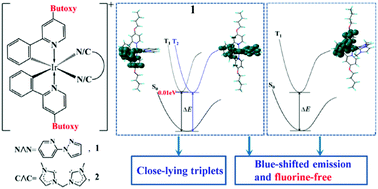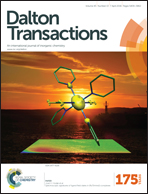Toward fluorine-free blue-emitting cationic iridium complexes: to generate emission from the cyclometalating ligands with enhanced triplet energy†
Abstract
A route toward fluorine-free blue-emitting cationic iridium complexes, to generate emission from the cyclometalating ligands with enhanced triplet energy, has been proposed and demonstrated. Attaching electron-donating groups to the pyridine moieties of the ppy-type cyclometalating ligands (Hppy is 2-phenylpyridine) enhances the triplet (3π–π*) energy of the ligand, and the use of electron-rich or non-conjugated ancillary ligands ensures that the emission is generated from the 3π–π* states of cyclometalating ligands. By this molecular design, [Ir(buoppy)2(pzpy)]PF6 (1) and [Ir(buoppy)2(bim-cb)]PF6 (2) have been developed, with 4-butoxy-2-phenylpyridine (buoppy) as the cyclometalating ligand and electron-rich 2-(1H-pyrazol-1-yl)pyridine (pzpy) or non-conjugated N-heterocyclic dicarbene (bim-cb) as the ancillary ligands. Complexes 1 and 2 give emission with major emission peaks around 465 nm, which is among the bluest reported for fluorine-free cationic iridium complexes. For both complexes, the emission is generated from the 3π–π* states centered on buoppy. For complex 1, the charge-transfer (Ir/buoppy → pzpy) state is dominated by non-radiative deactivation and it behaves as a non-radiative deactivation channel for the emissive buoppy-centered 3π–π* states which lies close to the charge-transfer state in energy. Such a non-radiative deactivation channel is largely suppressed in the rigid matrix, and is eliminated in complex 2 with a non-conjugated dicarbene ancillary ligand.


 Please wait while we load your content...
Please wait while we load your content...